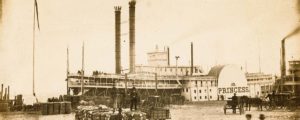Inexhaustibly, the Union Pacific built westward and the Central Pacific built eastward until their rails joined to form the first transcontinental railroad on May 10, 1869, with the driving of a golden spike at Promontory Point, Utah. Countless books, magazines and history teachers have said so. Well, that was indeed the date of the great American railroad linkup, but they are wrong on several points.
In truth, the last spike was made of ordinary iron, and it was driven at Promontory Summit, about 35 miles north of Promontory Point, in what was then Utah Territory. These may be viewed as small points about a pivotal event in American history, but here is a larger point: Although Promontory Summit, where the “Wedding of the Rails” ceremony took place, became Promontory Station and later Promontory, a center for local dry farming, this important historical site was all but forgotten for nearly a century. Not until July 30, 1965, did the U.S. government establish the Golden Spike National Historic Site. Renewed interest in the “Last Spike Site” did not end all historical misconceptions, of course. Still, close to 30,000 people showed up at the right place in 1969 for the centennial celebration, and even the 125th anniversary in 1994 drew 14,000 spike buffs.
Here are a few other points worth noting about a monumental endeavor—made possible by the backbreaking labor of mostly Chinese (Central Pacific) and Irishmen (Union Pacific)—that began America’s honeymoon with railroads and changed the way Americans thought about time, landscapes and horizons:
The “Wedding of the Rails” ceremony was originally to take place on May 8, 1869. Central Pacific President Leland Stanford arrived on time in his private railroad car. Union Pacific Vice President Thomas C. Durant’s train, however, was late. It seems that tie cutters in Wyoming wouldn’t let the VP pass until they were paid five months’ worth of back wages. The UP had to make a special payroll run before Durant could continue on to Promontory Summit.
The Promontory Point and Summit mix-up occurred right away when reporters, many of whom didn’t even see the ceremony, looked at the maps of the day and only saw “Promontory Point.” Before 1869 was out, the terminus of the UP and CP was moved some 60 miles to the southwest from Promontory Summit to Ogden, making the former a mere whistle-stop on the transcontinental railroad. Promontory was off the main line by 1904 and by World War II was no longer even served by the railroad.
There really was a golden spike; in fact, there were three of them, as well as a silver spike and a fifth spike that was a blend of gold, silver and iron. Four of these ceremonial spikes (one of the gold ones didn’t make it) were “tapped” rather than “driven” into a laurel wood tie that had been brought to the scene with four holes already drilled into it. After that show, the laurel wood tie and shiny spikes were removed. A permanent pine tie was laid down, and three regular iron spikes were driven into it. Then a fourth iron spike, technically the “last spike,” was wired to the transcontinental telegraph line so that the big blow from the iron spike hammer could be heard from coast to coast.
The honor of driving the last spike went to Stanford, but his big blow was a clear miss. It didn’t matter to the telegraph operator, who immediately sent off the one-word message: “DONE.” French immigrant Alexander Toponce, who witnessed the ceremony, wrote that a “howl went up” when Stanford hammered the rail instead of the spike. “Irish, Chinese, Mexicans, and everybody yelled with delight,” recalled Toponce. “Everybody slapped everybody else on the back and yelled ‘He missed it. Yee.’” Durant then took spike hammer in hand and followed up with an anticlimactic second miss.
Although there were three spikes of solid gold, the one that became famous as “the golden spike” was compliments of Stanford’s San Francisco friend David Hewes. Some $350 of Hewes’ own gold was shaped at a foundry into a 55⁄8-inch-long, 14-ounce spike. “The Last Spike” was engraved on top. Two of the sides were engraved with the names of Central Pacific officials. A third side provided news: “The Pacific Railroad ground broken Jany 8th 1863 and completed May 8th 1869.” The fourth side provided inspiration: “May God continue the unity of our Country as the Railroad unites the two great Oceans of the world.”
The locomotives whose cowcatchers (or pilots) touched on May 10, 1869, were the Central Pacific’s Jupiter, which burned wood and had a balloon-style smokestack, and the Union Pacific’s No. 119, a coal-burner with a straight smokestack. “It was a great occasion,” recalled Toponce, “everyone carrying off souvenirs and there are enough splinters of the last tie in museums to make a good bonfire….The engineers shook hands and had their pictures taken and each broke a bottle of champagne on the pilot of the other’s engine and had their pictures taken again.”
A re-created Jupiter and No. 119 as well as reenactors now perform the picturesque Last Spike Ceremony regularly. The two engines, a spike and the words “Crossroads of the West” appear on the “Utah quarter,” issued in 2007. Despite cell phones and the Internet, the task of uniting the nation is never really done.
For information on the Golden Spike National Historic Site, visit www.utah.com/national sites/golden_spike.htm or call 435-471-2209.
Originally published in the April 2007 issue of Wild West. To subscribe, click here.




